Economic Analysis of Austria: GDP, Inflation, and Industries
VerifiedAdded on 2022/10/03
|6
|778
|225
Report
AI Summary
This report provides an overview of the Austrian economy, examining its economic growth, GDP, and inflation rates. It highlights the leading industries, including the service, industrial, and agricultural sectors. The report discusses the impact of the global financial crisis and other economic and political factors. The analysis includes an examination of the labor market, the role of tourism, and the country's overall economic performance. The report uses various sources to present a comprehensive view of Austria's economic landscape, including its strengths, weaknesses, and future prospects. The report concludes by summarizing the key findings and the current state of the Austrian economy, and it references various sources to support its claims.
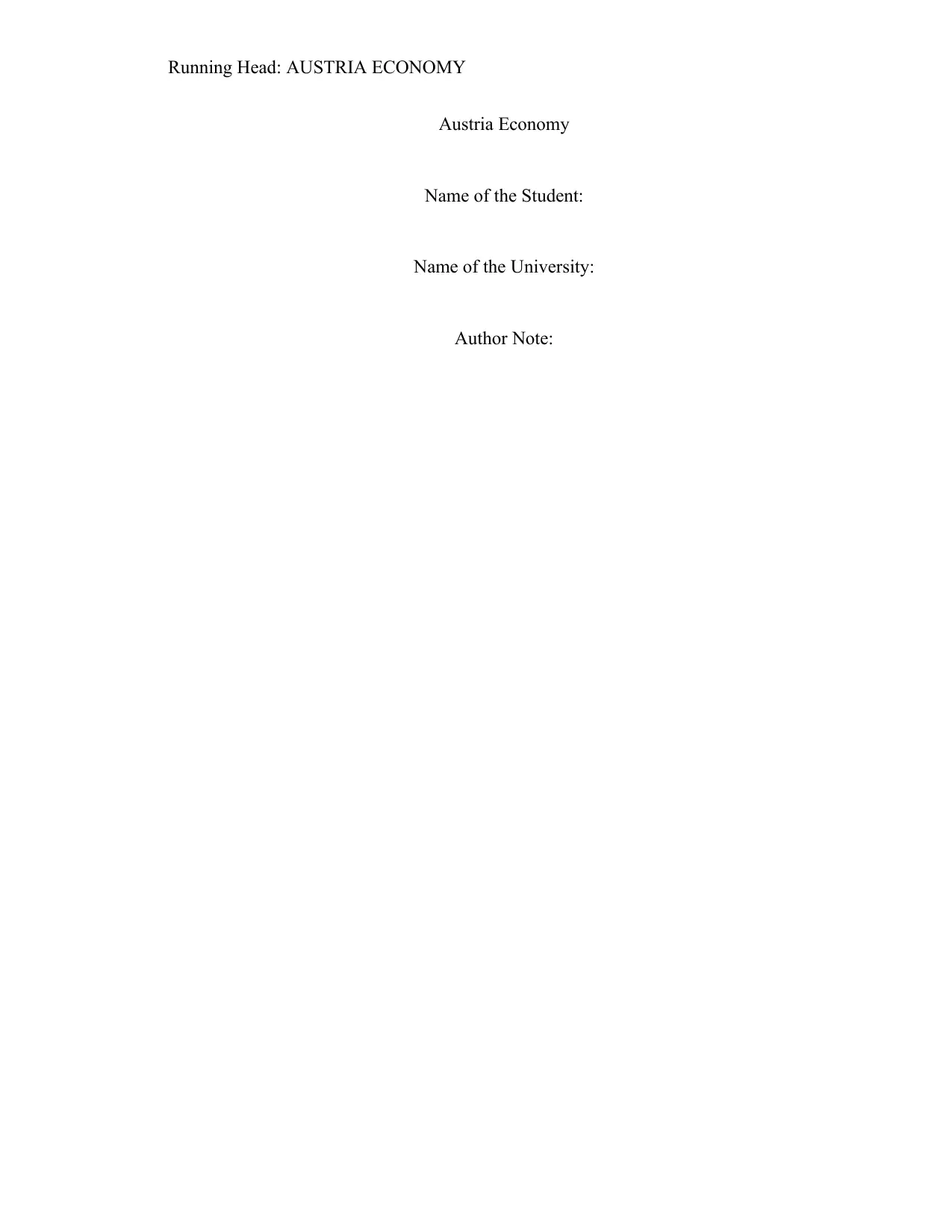
Running Head: AUSTRIA ECONOMY
Austria Economy
Name of the Student:
Name of the University:
Author Note:
Austria Economy
Name of the Student:
Name of the University:
Author Note:
Paraphrase This Document
Need a fresh take? Get an instant paraphrase of this document with our AI Paraphraser
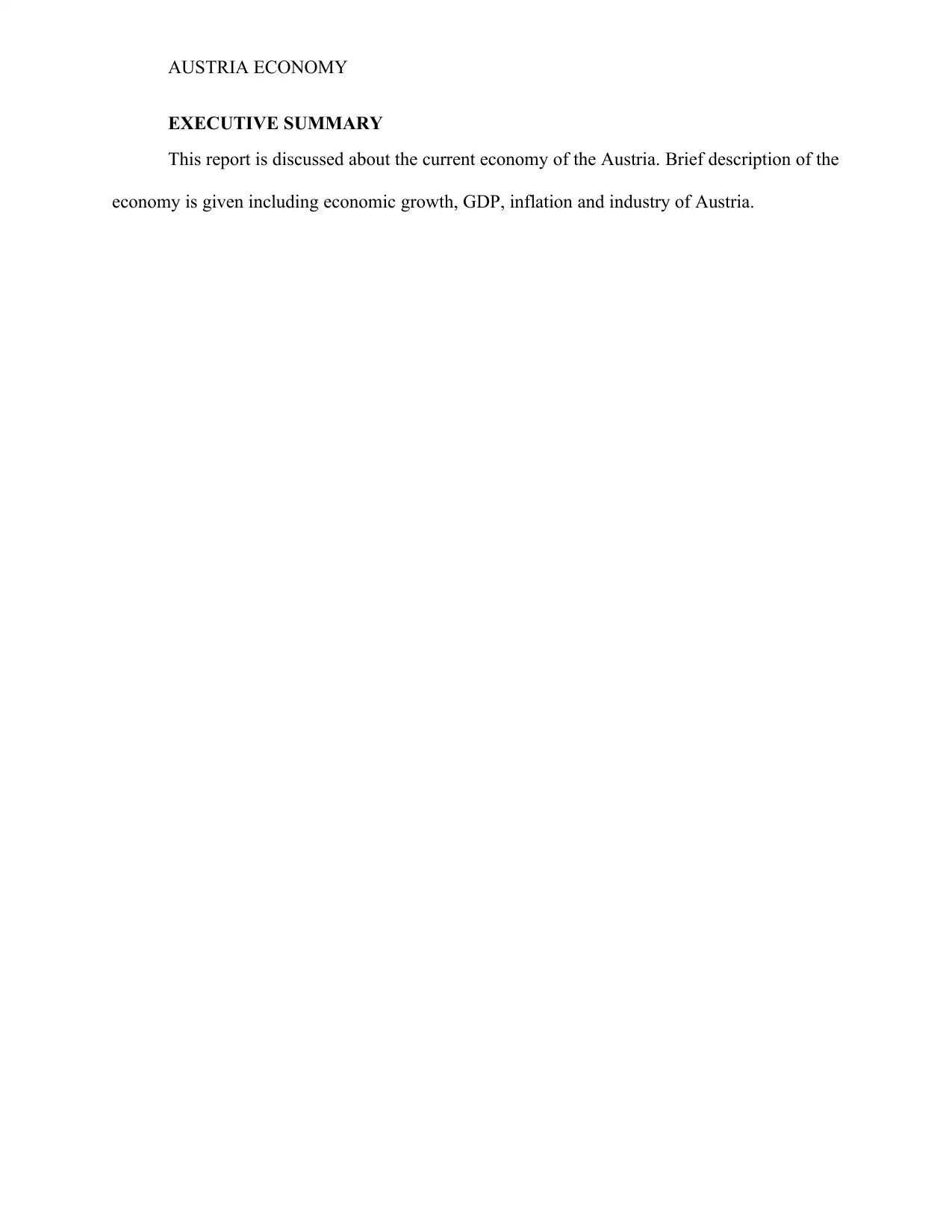
AUSTRIA ECONOMY
EXECUTIVE SUMMARY
This report is discussed about the current economy of the Austria. Brief description of the
economy is given including economic growth, GDP, inflation and industry of Austria.
EXECUTIVE SUMMARY
This report is discussed about the current economy of the Austria. Brief description of the
economy is given including economic growth, GDP, inflation and industry of Austria.
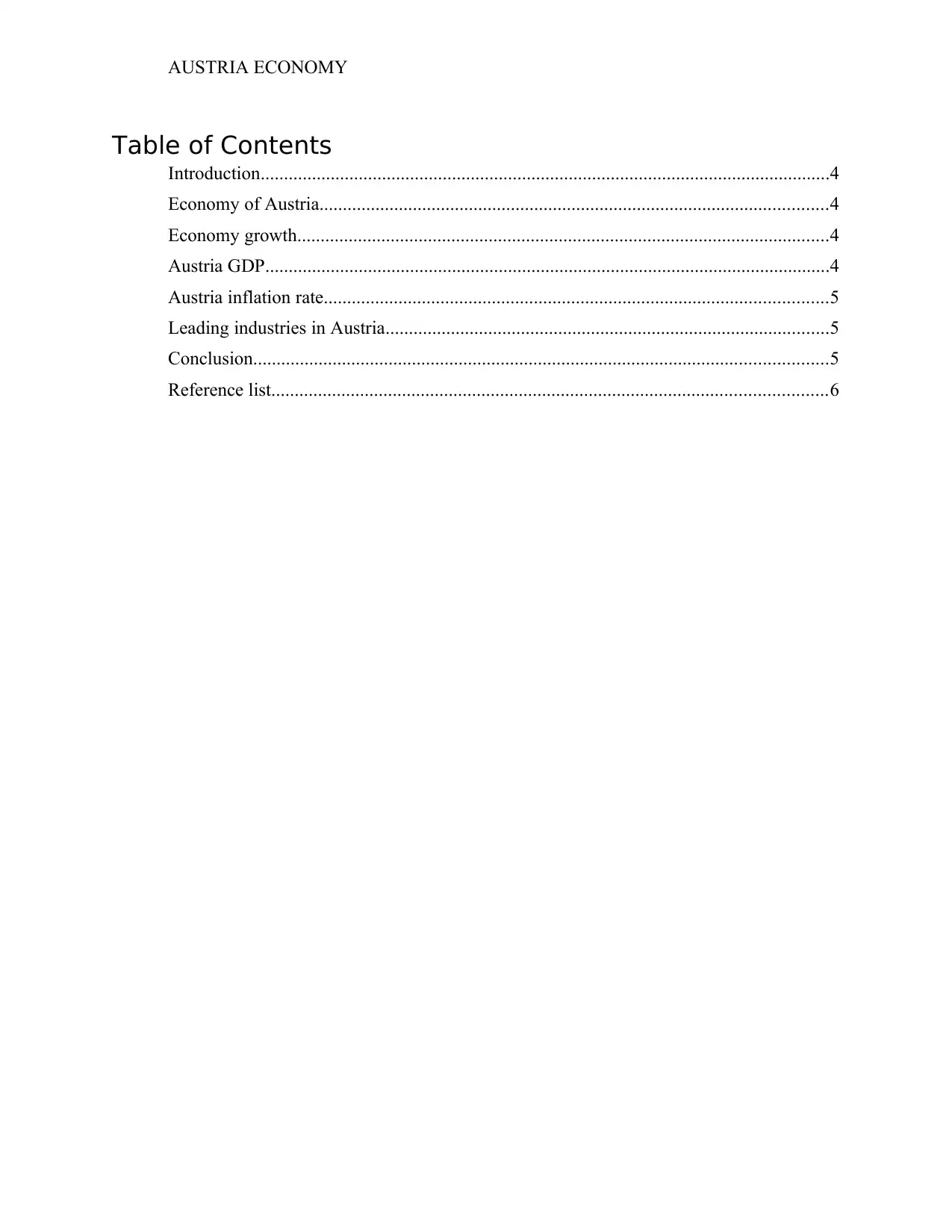
AUSTRIA ECONOMY
Table of Contents
Introduction..........................................................................................................................4
Economy of Austria.............................................................................................................4
Economy growth..................................................................................................................4
Austria GDP.........................................................................................................................4
Austria inflation rate............................................................................................................5
Leading industries in Austria...............................................................................................5
Conclusion...........................................................................................................................5
Reference list.......................................................................................................................6
Table of Contents
Introduction..........................................................................................................................4
Economy of Austria.............................................................................................................4
Economy growth..................................................................................................................4
Austria GDP.........................................................................................................................4
Austria inflation rate............................................................................................................5
Leading industries in Austria...............................................................................................5
Conclusion...........................................................................................................................5
Reference list.......................................................................................................................6
⊘ This is a preview!⊘
Do you want full access?
Subscribe today to unlock all pages.

Trusted by 1+ million students worldwide
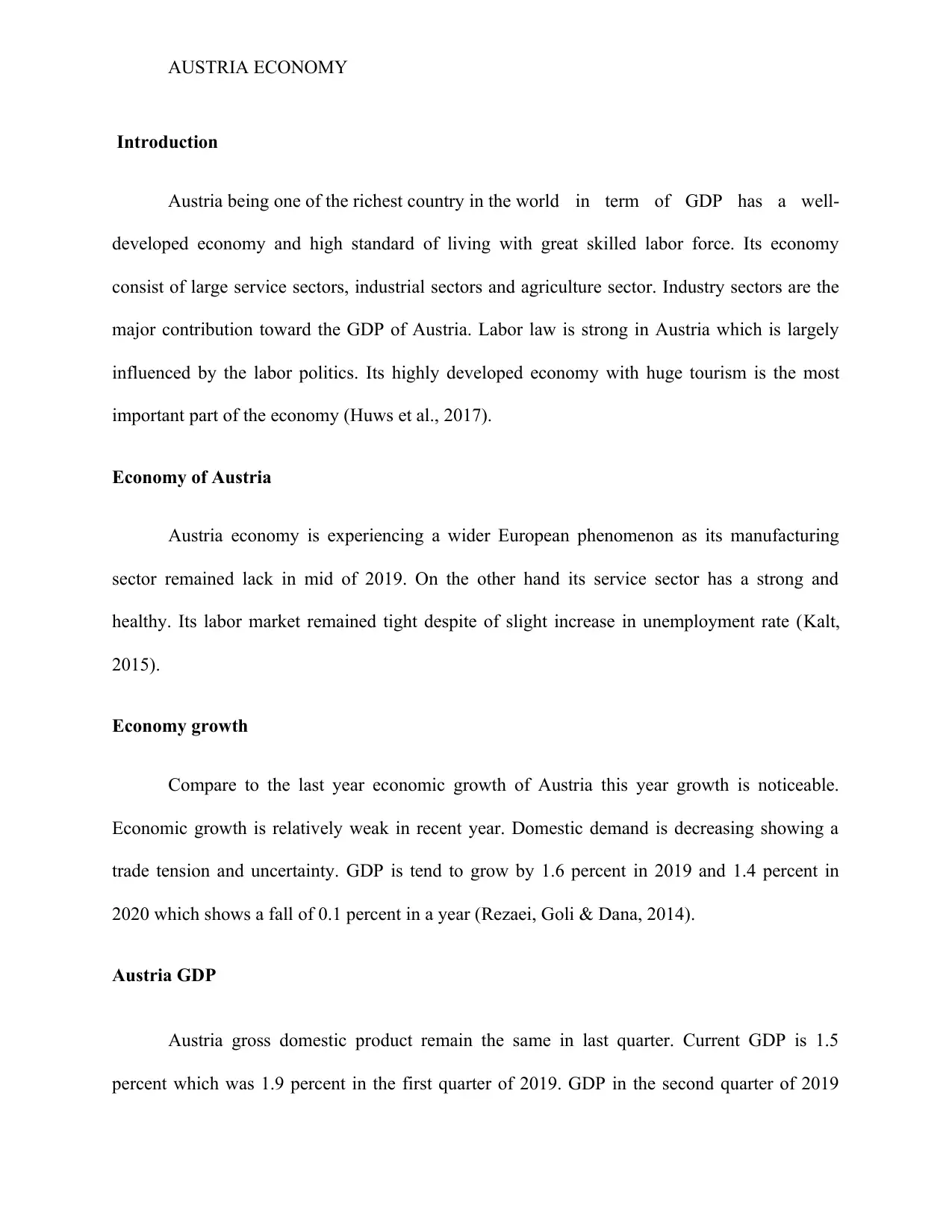
AUSTRIA ECONOMY
Introduction
Austria being one of the richest country in the world in term of GDP has a well-
developed economy and high standard of living with great skilled labor force. Its economy
consist of large service sectors, industrial sectors and agriculture sector. Industry sectors are the
major contribution toward the GDP of Austria. Labor law is strong in Austria which is largely
influenced by the labor politics. Its highly developed economy with huge tourism is the most
important part of the economy (Huws et al., 2017).
Economy of Austria
Austria economy is experiencing a wider European phenomenon as its manufacturing
sector remained lack in mid of 2019. On the other hand its service sector has a strong and
healthy. Its labor market remained tight despite of slight increase in unemployment rate (Kalt,
2015).
Economy growth
Compare to the last year economic growth of Austria this year growth is noticeable.
Economic growth is relatively weak in recent year. Domestic demand is decreasing showing a
trade tension and uncertainty. GDP is tend to grow by 1.6 percent in 2019 and 1.4 percent in
2020 which shows a fall of 0.1 percent in a year (Rezaei, Goli & Dana, 2014).
Austria GDP
Austria gross domestic product remain the same in last quarter. Current GDP is 1.5
percent which was 1.9 percent in the first quarter of 2019. GDP in the second quarter of 2019
Introduction
Austria being one of the richest country in the world in term of GDP has a well-
developed economy and high standard of living with great skilled labor force. Its economy
consist of large service sectors, industrial sectors and agriculture sector. Industry sectors are the
major contribution toward the GDP of Austria. Labor law is strong in Austria which is largely
influenced by the labor politics. Its highly developed economy with huge tourism is the most
important part of the economy (Huws et al., 2017).
Economy of Austria
Austria economy is experiencing a wider European phenomenon as its manufacturing
sector remained lack in mid of 2019. On the other hand its service sector has a strong and
healthy. Its labor market remained tight despite of slight increase in unemployment rate (Kalt,
2015).
Economy growth
Compare to the last year economic growth of Austria this year growth is noticeable.
Economic growth is relatively weak in recent year. Domestic demand is decreasing showing a
trade tension and uncertainty. GDP is tend to grow by 1.6 percent in 2019 and 1.4 percent in
2020 which shows a fall of 0.1 percent in a year (Rezaei, Goli & Dana, 2014).
Austria GDP
Austria gross domestic product remain the same in last quarter. Current GDP is 1.5
percent which was 1.9 percent in the first quarter of 2019. GDP in the second quarter of 2019
Paraphrase This Document
Need a fresh take? Get an instant paraphrase of this document with our AI Paraphraser
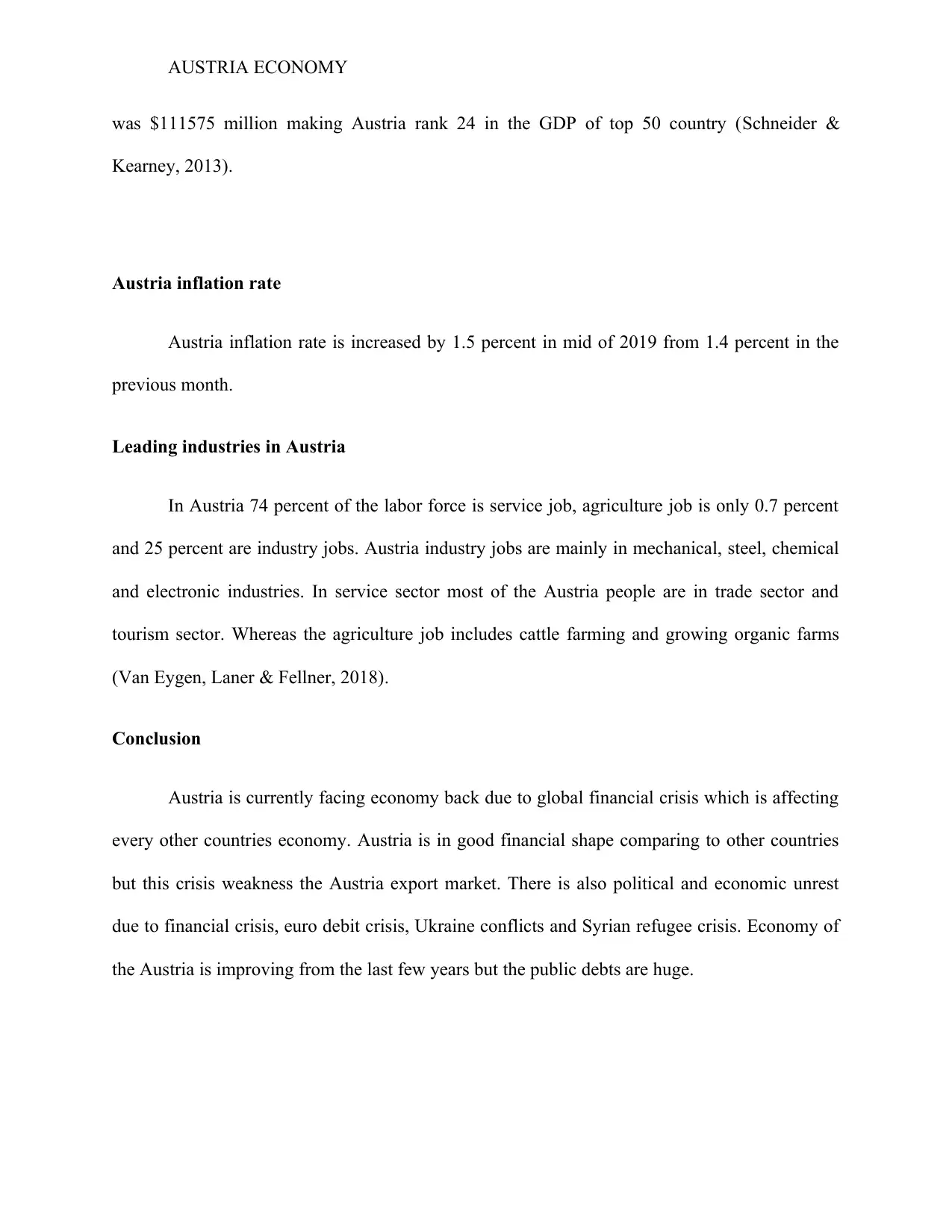
AUSTRIA ECONOMY
was $111575 million making Austria rank 24 in the GDP of top 50 country (Schneider &
Kearney, 2013).
Austria inflation rate
Austria inflation rate is increased by 1.5 percent in mid of 2019 from 1.4 percent in the
previous month.
Leading industries in Austria
In Austria 74 percent of the labor force is service job, agriculture job is only 0.7 percent
and 25 percent are industry jobs. Austria industry jobs are mainly in mechanical, steel, chemical
and electronic industries. In service sector most of the Austria people are in trade sector and
tourism sector. Whereas the agriculture job includes cattle farming and growing organic farms
(Van Eygen, Laner & Fellner, 2018).
Conclusion
Austria is currently facing economy back due to global financial crisis which is affecting
every other countries economy. Austria is in good financial shape comparing to other countries
but this crisis weakness the Austria export market. There is also political and economic unrest
due to financial crisis, euro debit crisis, Ukraine conflicts and Syrian refugee crisis. Economy of
the Austria is improving from the last few years but the public debts are huge.
was $111575 million making Austria rank 24 in the GDP of top 50 country (Schneider &
Kearney, 2013).
Austria inflation rate
Austria inflation rate is increased by 1.5 percent in mid of 2019 from 1.4 percent in the
previous month.
Leading industries in Austria
In Austria 74 percent of the labor force is service job, agriculture job is only 0.7 percent
and 25 percent are industry jobs. Austria industry jobs are mainly in mechanical, steel, chemical
and electronic industries. In service sector most of the Austria people are in trade sector and
tourism sector. Whereas the agriculture job includes cattle farming and growing organic farms
(Van Eygen, Laner & Fellner, 2018).
Conclusion
Austria is currently facing economy back due to global financial crisis which is affecting
every other countries economy. Austria is in good financial shape comparing to other countries
but this crisis weakness the Austria export market. There is also political and economic unrest
due to financial crisis, euro debit crisis, Ukraine conflicts and Syrian refugee crisis. Economy of
the Austria is improving from the last few years but the public debts are huge.
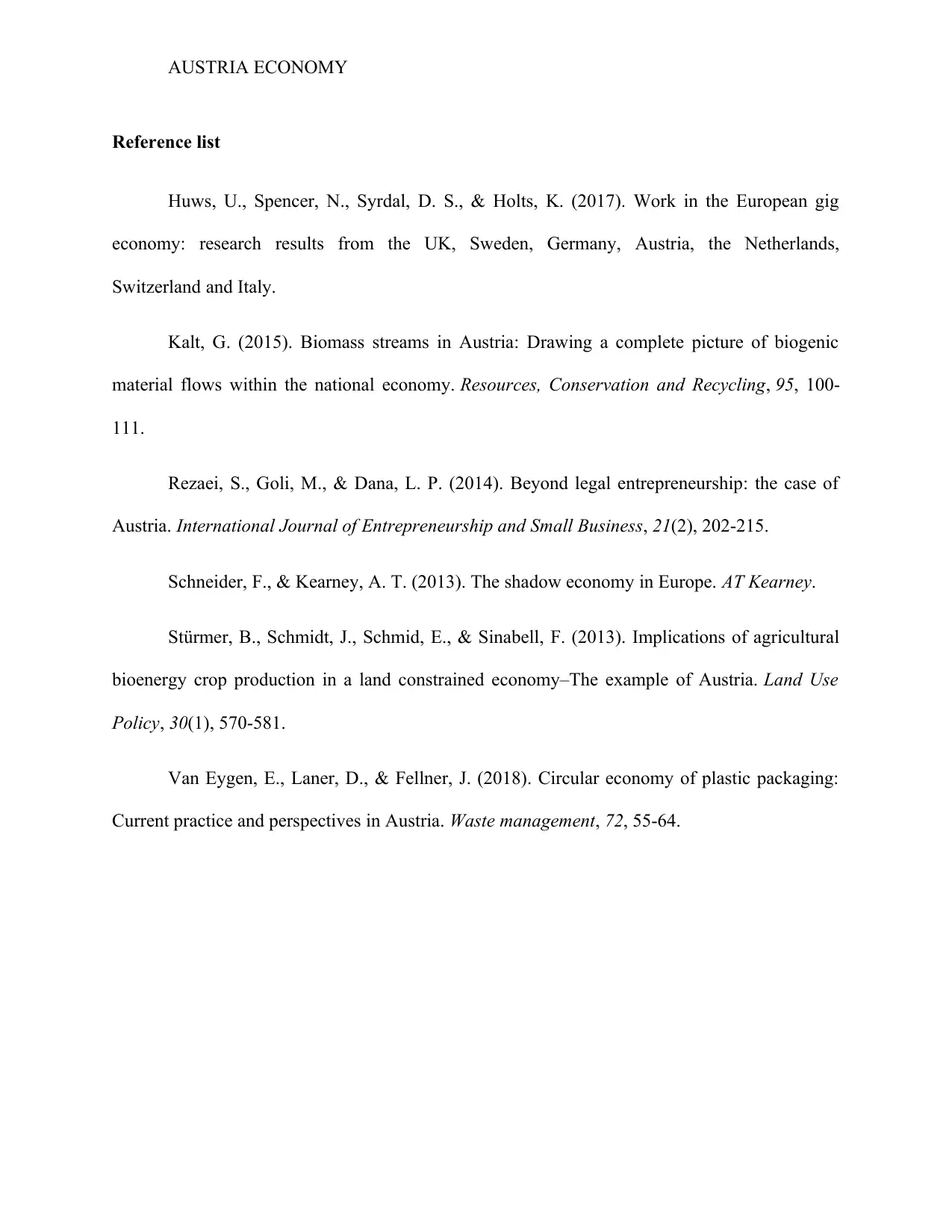
AUSTRIA ECONOMY
Reference list
Huws, U., Spencer, N., Syrdal, D. S., & Holts, K. (2017). Work in the European gig
economy: research results from the UK, Sweden, Germany, Austria, the Netherlands,
Switzerland and Italy.
Kalt, G. (2015). Biomass streams in Austria: Drawing a complete picture of biogenic
material flows within the national economy. Resources, Conservation and Recycling, 95, 100-
111.
Rezaei, S., Goli, M., & Dana, L. P. (2014). Beyond legal entrepreneurship: the case of
Austria. International Journal of Entrepreneurship and Small Business, 21(2), 202-215.
Schneider, F., & Kearney, A. T. (2013). The shadow economy in Europe. AT Kearney.
Stürmer, B., Schmidt, J., Schmid, E., & Sinabell, F. (2013). Implications of agricultural
bioenergy crop production in a land constrained economy–The example of Austria. Land Use
Policy, 30(1), 570-581.
Van Eygen, E., Laner, D., & Fellner, J. (2018). Circular economy of plastic packaging:
Current practice and perspectives in Austria. Waste management, 72, 55-64.
Reference list
Huws, U., Spencer, N., Syrdal, D. S., & Holts, K. (2017). Work in the European gig
economy: research results from the UK, Sweden, Germany, Austria, the Netherlands,
Switzerland and Italy.
Kalt, G. (2015). Biomass streams in Austria: Drawing a complete picture of biogenic
material flows within the national economy. Resources, Conservation and Recycling, 95, 100-
111.
Rezaei, S., Goli, M., & Dana, L. P. (2014). Beyond legal entrepreneurship: the case of
Austria. International Journal of Entrepreneurship and Small Business, 21(2), 202-215.
Schneider, F., & Kearney, A. T. (2013). The shadow economy in Europe. AT Kearney.
Stürmer, B., Schmidt, J., Schmid, E., & Sinabell, F. (2013). Implications of agricultural
bioenergy crop production in a land constrained economy–The example of Austria. Land Use
Policy, 30(1), 570-581.
Van Eygen, E., Laner, D., & Fellner, J. (2018). Circular economy of plastic packaging:
Current practice and perspectives in Austria. Waste management, 72, 55-64.
⊘ This is a preview!⊘
Do you want full access?
Subscribe today to unlock all pages.

Trusted by 1+ million students worldwide
1 out of 6
Related Documents
Your All-in-One AI-Powered Toolkit for Academic Success.
+13062052269
info@desklib.com
Available 24*7 on WhatsApp / Email
![[object Object]](/_next/static/media/star-bottom.7253800d.svg)
Unlock your academic potential
Copyright © 2020–2025 A2Z Services. All Rights Reserved. Developed and managed by ZUCOL.





